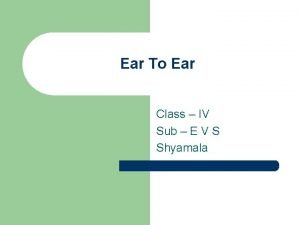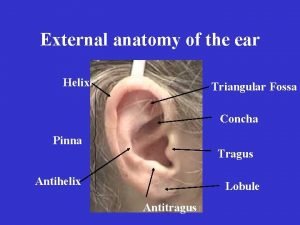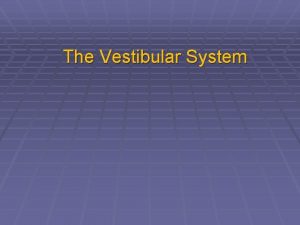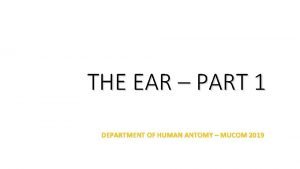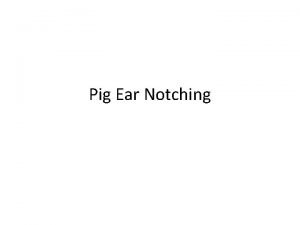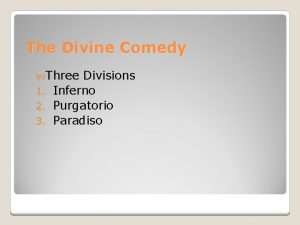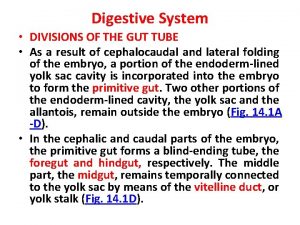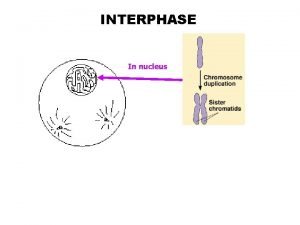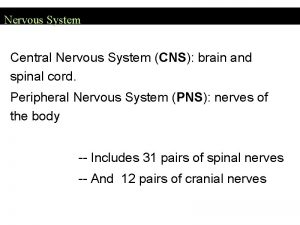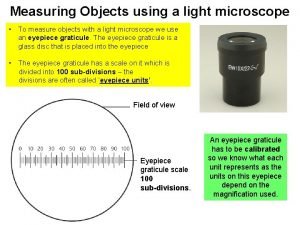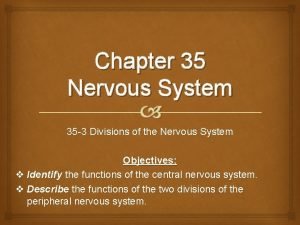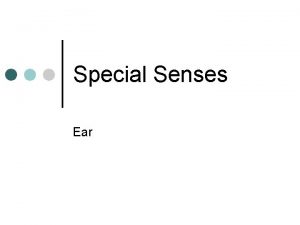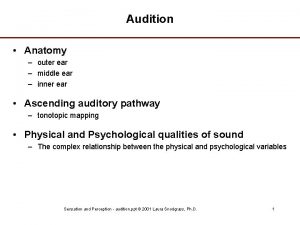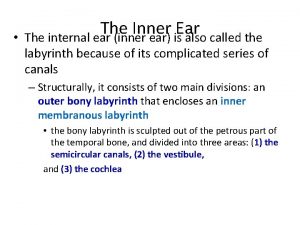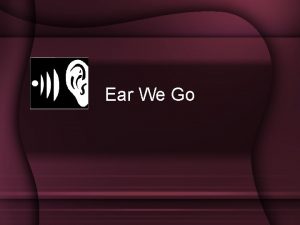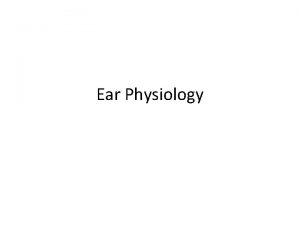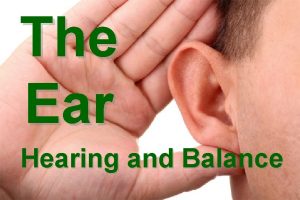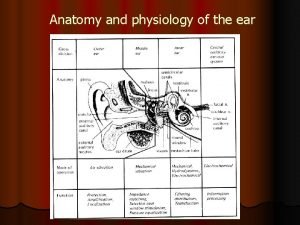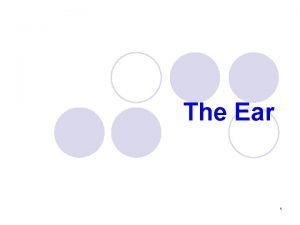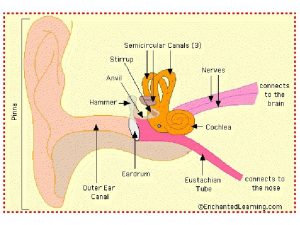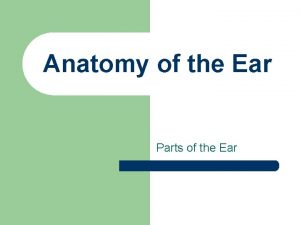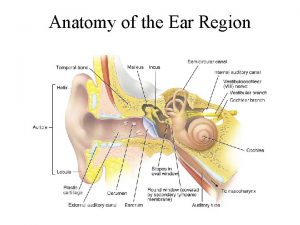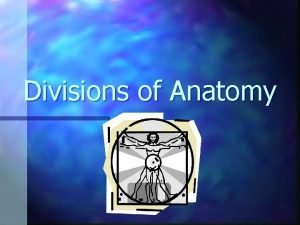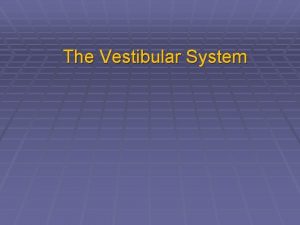Anatomy of the Ear Dr isazadehfar Major Divisions


























- Slides: 26

Anatomy of the Ear Dr isazadehfar

Major Divisions of the Ear Peripheral Mechanism VIII Outer Middle Inner Cranial Ear Ear Nerve Central Mechanism Brain

Outer Ear Pinna Preauricular Tags External Auditory Meatus Preauricular Pits EAM Cerumen

Pinna

Function of Outer Ear • • • Collect sound Localization Resonator Protection Sensitive (earlobe) Other?

Pinna • The visible portion that is commonly referred to as "the ear" • Helps localize sound sources • Directs sound into the ear • Each individual's pinna creates a distinctive imprint on the acoustic wave traveling into the auditory canal

External Auditory Meatus • Extends from the pinna to the tympanic membrane – About 26 millimeters (mm) in length and 7 mm in diameter in adult ear. – Size and shape vary among individuals. • Protects the eardrum • Resonator – Provides about 10 decibels (d. B) of gain to the eardrum at around 3, 300 Hertz (Hz). • The net effect of the head, pinna, and ear canal is that sounds in the 2, 000 to 4, 000 Hz region are amplified by 10 to 15 d. B. – Sensitivity to sounds greatest in this frequency region – Noises in this range are the most hazardous to hearing

Cerumen • The purpose of wax: – Repel water – Trap dust, sand particles, microorganisms, and other debris – Moisturize epithelium in ear canal – Odor discourages insects – Antibiotic, antiviral, antifungal properties – Cleranse ear canal

Middle Ear Virtual Tour of the Ear Middle Ear Cavity Tympanic Membrane Ossicles Middle Ear Muscles Eustachian Tube Mastoid Ossicles Middle Ear Muscles Mastoid Eustachian Tube Function Amplifier Cholesteatoma Temporal bone fractures Otitis Media PE tubes Otosclerosis

Function of Middle Ear • Conduction – Conduct sound from the outer ear to the inner ear • Protection – Creates a barrier that protects the middle and inner areas from foreign objects – Middle ear muscles may provide protection from loud sounds • Transducer – Converts acoustic energy to mechanical energy – Converts mechanical energy to hydraulic energy • Amplifier – Transformer action of the middle ear – only about 1/1000 of the acoustic energy in air would be transmitted to the inner-ear fluids (about 30 d. B hearing loss)

Tympanic Membrane • The eardrum separates the outer ear from the middle ear • Creates a barrier that protects the middle and inner areas from foreign objects • Cone-shaped in appearance – about 17. 5 mm in diameter • The eardrum vibrates in response to sound pressure waves. • The membrane movement is incredibly small – as little as one-billionth of a centimeter

Eustachian Tube • The eustachian tube connects the front wall of the middle ear with the nasopharynx • The eustachian tube also operates like a valve, which opens during swallowing and yawning – This equalizes the pressure on either side of the eardrum, which is necessary for optimal hearing. – Without this function, a difference between the static pressure in the middle ear and the outside pressure may develop, causing the eardrum to displace inward or outward • This reduces the efficiency of the middle ear and less acoustic energy will be transmitted to the inner ear.

Ossicles • Malleus (hammer) • Incus (anvil) • Stapes (stirrup) smallest bone of the body

Transformer/Amplifier • Transform the vibrating motion of the eardrum into motion of the stapes. • The middle ear enhances the transfer of acoustical energy in two ways: – The area of the eardrum is about 17 times larger than the oval window • The effective pressure (force per unit area) is increased by this amount. – The ossicles produce a lever action that further amplifies the pressure • Without the transformer action of middle ear, about 1/1000 of acoustic energy in air transmitted to inner-ear fluids (about 30 d. B loss). • Malleus and incus vibrate together, transmitting the sound waves from the eardrum to the footplate of the stapes (this pushes the oval window in and out)(mechanical energy)

Mastoid

Otosclerosis • Develops most frequently between ages of 10 and 30. • About 10– 15% of patients have unilateral loss. • Affects women more frequently than men by a ratio of 2: 1. • Pregnancy once thought to be a risk factor for the development and / or worsening of otosclerosis…recent studies have disputed this. • May progress to nerve deafness called cochlear otosclerosis.

Inner Ear Vestibular semicircular canals utricle and saccule Auditory Vestibular Cochlear

Function of Inner Ear • Convert mechanical sound waves to neural impulses that can be recognized by the brain for: – Hearing – Balance

Cochlea • The cochlea resembles a snail shell and spirals for about 2 3/4 turns around a bony column • Within the cochlea are three canals: – Scala Vestibuli – Scala Tympani – Scala Media

Organ of Corti

Organ of Corti

Organ of Corti

OHC vs. IHC Function

VIII Cranial Nerve Virtual Tour of the Ear Auditory Branch Vestibular Branch Spiral ganglion Acoustic Tumors

Acoustic Neuroma

Central Auditory Mechanism Virtual Tour of the Ear Auditory Path
 Animal whose ears we cannot see
Animal whose ears we cannot see Animals whose ears we cannot see
Animals whose ears we cannot see Where are loins on a human
Where are loins on a human Major division and parts of the nervous system
Major division and parts of the nervous system Nervous system major divisions
Nervous system major divisions Triangular fossa function
Triangular fossa function Ampulla anatomy ear
Ampulla anatomy ear Acoustic meatus
Acoustic meatus Pig ears
Pig ears Gears types
Gears types What are the three divisions of comedy
What are the three divisions of comedy Foregut midgut hindgut divisions
Foregut midgut hindgut divisions Section 35-3 divisions of the nervous system
Section 35-3 divisions of the nervous system Number of divisions in mitosis
Number of divisions in mitosis Northern ireland administrative divisions
Northern ireland administrative divisions Peripheral nervous system
Peripheral nervous system Peritoneal sac
Peritoneal sac Divisions of family practice
Divisions of family practice Hosa divisions
Hosa divisions Divisions of the nervous system
Divisions of the nervous system Elsevier
Elsevier Label the parts of the main division of the nervous system
Label the parts of the main division of the nervous system Eyepiece graticule
Eyepiece graticule Abdominal divisions
Abdominal divisions 35-3 divisions of the nervous system
35-3 divisions of the nervous system Structure of investment banks
Structure of investment banks Investment bank divisions
Investment bank divisions
